| Jan-05-19 | | Nairaboi: Beautiful game by black. |
|
Sep-28-21
 | | KEG: An exciting game to play over, with White's two connected passed pawns in the center and Black's King-side pawn advance. von Popiel had good winning chances, but he flubbed them and Reggio finally marching to victory after White's error on move 42. Some earlier portions of the game are painful to observe with both sides seemingly having lost the thread of the game. 1, e4 e5
2. Nf3 Nc6
3. c3
Ponziani's Opening, a von Popiel favorite.
3... Nf6
The text and 3...d5 are most usual. The latter is perhaps strongest, but the text is sufficient for equality. 4, d4 d5
4...exd4 is best.
5. Bb5 Nxe4
5...exd4 is again best.
6. Nxe5
As played by von Popiel in his loss to Jacob at Munich 1900. The text itself looks fine. 6... Bd7
7. NxB QxN
8. 0-0 Be7

click for larger view9. f3
The developing 9. Nd2, as played by von Popiel himself in the above-referenced game against Jacob was best. 9... Nd6
10. Ba4
10. Bd3 looks more logical.
10... 0-0
11. f4
Developing his Knight to d2 or a3 looks better.
After the text, the position was:

click for larger view"The position now has many of the characteristics of a closed game. Direct threats are few and both players are thinking about the ending." (Tournament Book) I for one have no idea what von Popiel and Reggio were thinking about at this point. From the diagrammed position, it would seem impossible to have predicted the themes that would soon develop (i.e., White's center pawns against Black's pawn advance on the King's side). 11... f5
12. Nd2 b5
12...Ne4; 12...a6; or 12...Qe6 would be better.
13. Bc2

click for larger view13. Bb3 puts stronger pressure on the center and was surely better. 13... Ne4
14. Nf3 Rf6
A doubtful venture by the Black Rook.
15. Qd3 a6

click for larger viewWhite held at most a small advantage here. Beginning at this point, as I will discuss in my next post on this game, play became very spotty. What proved to be the key ideas of this game still lay in the future. |
|
Sep-29-21
 | | KEG: Post II
16. Be3
16. a4 or 16. Ne5 were better.
16... Rg6
Misguided. After White's last move, he should have probably played Na5 followed by Qc8-b7; or maybe 16...Qe8. 17. Bb3
More thoughtless play. White should advance on the Queen side with 17. a4 or maybe 17. b4. But the text worked out well because Reggio responded: 17... Kh8
Unduly frightened by White's last move. But Reggio paid no price for this nervous response since von Popiel for the third consecutive move failed to play 18. 14 but instead dithered with: 18. Rae1 Bf6
Another weak effort.
19. Bd1
Why not 19. Ne5 immediately?
19... Ne7
Reggio still played as if in a fog.
20. Ne5
Finally getting on track.
20... BxN
This gives von Popiel a dangerous passed pawn in the center, but everythng else seems even worse. 21. fxB

click for larger view21... Rb6
22. Rf3 g5?!
The beginning of a pawn advance on the King side. This proved to be a theme that would eventually allow Reggio to win the game, but along the way White's center should probably have decided the contest for von Popiel. After the text, the position was:

click for larger view23. Ref1
This superficially attractive move proves useless. von Popiel stood better at this point, and should have regrouped with 23. Bc2 or 23. Rff1. 23... Rf8
Having played 22...g5, why not 23...f4 now! Moreover, placing the Rook here gave White a tempo. 24. g4?
Handing Black a passed pawn.
24... f4
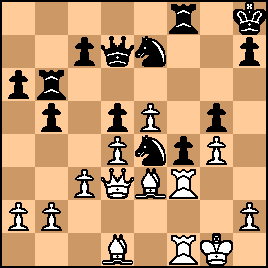
click for larger viewThe themes of the game were now taking shape. White's center versus Black's pawn advance on the King's pawn. 25. Rh3
Exploiting The unfortunate position of the Black Rook on f8. 25... Ng6

click for larger view26. Bc1
The weakest of the three retreating moves available to the White Bishop. 26... c5

click for larger viewThe play had been less than stellar, but the position at this stage was double-edged and quite exciting. |
|
Sep-30-21
 | | KEG: Post III
27. Bf3
White was slightly worse at this point, and should probably have anticipated play on the Queen's side with 27. b3. 27... c4
This only solidifies White's pawn chain. 27...cxd4 was better. 28. Qe2 b4?!
Now Black's Queen-side and center pawns become weak and White's e-pawn (and later his d-pawn) becomes even more formidable. The position was now:

click for larger view29. BxN
29. cxb4 first was simpler.
29... dxB
30. Qxe4 Qxg4+

click for larger view31. Qg2?
The move 30 time control had been reached, so this mistake can not be explained as being the result of time pressure. White could have taken advantage of the pinned Black f-pawn with 31. Rg3 with approximate equality. The text could have led to trouble for White. 31... QxQ+?
The Tournament Book called this forced, saying that 31...Qf5 would have been a mistake because of 32. Rh5. But Black would then be better after 32...bxc3 33. Rxg5 Qd3 34. bxc3 Rb1. 32. cxb4 would have been better for White in this line, but Black would still have the edge. But Reggio could simply have played 31...Qd7 and Black is then much better in all variations. 32. KxQ

click for larger viewAfter all the ups and downs, a complicated but seemingly balanced endgame had been reached. Reggio should just have followed general rules and brought his King into play with 32...Kg7, or maybe played 32...bxc3 first. Instead: 32... a5?
The Tournament Book correctly noted that 32...Nh4+ would be bad in light of 33. RxN! gxR 34. Kf3 after which, despite being a pawn down, White has good winning chances. But the text should have lost forthwith, the position now being: 
click for larger view33. Kf3?
Missing the likely winning 33. Rh5 after which Black's goose appears to be cooked. After the sloppy text, Reggio was very much back in the game despite White's powerful two passed pawns in the center. 33... Kg7
As he should have played on his prior turn.
34. Ke4

click for larger viewBlack now had chances but White was definitely better. To quote the Tournament Book: "The Black pawns on f4 and g5 are tied down whereas the White pawns at d4 and e5 are ready to roll, backed by their king." (Tournament Book) In the following comedy of errors, however, the advantage swung back and forth until von Popiel's collapse on and after move 43. I will attempt to review the exciting but often exasperating ensuing play in my next post on this game. |
|
Sep-30-21
 | | KEG: Post IV
34... Ne7?
With 34...Rb5, 34...Rb7, or 34...h6, Black can probably survive. After the text, Reggio was in serious trouble, the position now being: 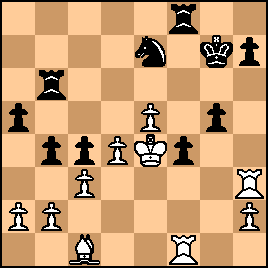
click for larger view35. Rg1
The Tournament Book incorrectly claimed that White could have won here, reaching that mistaken conclusion with faulty analysis: 35. d5 Rb5 36. Rd1 Rd8 [Now White can indeed win, but better and sufficient to save the day was 36...Re8--KEG] 37. d6 Ng6 [no better is 37...Re8 in light of the following spectacular variation: 38. dxN Rxe7 39. Rd5 RxR 40. KxR Rd7+ 41. Kxc4 Rd1 (seemingly saving the day, but White still has a win) 42. Bxf4! bxc3 43. Kxc3 gxB 44. Rf3 h1 45. Rxf4 Rxh2 46. a4 and White should win the Rook and Pawn ending--KEG[ 38. Rd5 RxR 39. KxR g4 [best--KEG] 40. Rh5 f3 41. Be3 [this wins, but even more decisive would be 41. Bg5--KEG] Nf4+? [this loses immediately, but the "better 41...bxc3 also loses after the following amazing line: 42. bxc3 f2 43. Bxf2 (losing a Rook but still winning) Nf4+ 44. Kxc4 NxR 45. Bb6 and White, though down a Rook in this ending, should still win--KEG] 42. BxN f2 43. Rf5 and wins. To return to the actual game, after 35. Rg1 the position was: 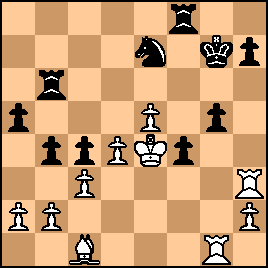
click for larger view35... h6
36. Rf3
"Threatening Rxf4, but improving the position of his opponent's King, bringing it towards e6." (Tournament Book) The above notwithstanding, the text was the only winning line for White, the position now being: 
click for larger view36... Kf7?
36...Ng6 was Black's only chance. Now, von Popiel could have torn up the Black King-side with 37. h4!. Instead, he again let Reggio back in the game with: 37. Rd1? Rd8
This left:

click for larger view38. h4
The best try for White.
The Tournament Book suggested that 38. d5 would lose for White. In fact, it would lead to equality after 38...Rb5. The Tournament Book here only considers 39. d6? which indeed should lose, but overlooks the variation that appears to save White: 39. Bxf4! gxB 40. Rxf4+ Ke8 41. d6 bxc3 42. bxc3 Rb2 43. Rf6 Re2+ 44. Kd4 Nc6+ 45. Kd5 Rc8 46. Rf5 Nd8 47. Rg1 Rd2+ 48. Ke4 Kd7 49. Rg7+ Kc6 50. Rf6 Kb6 51. Rf8 Kc6 52. Rgg8 Kd7 53. e6+ Kxe6 54. RxN Re2+ 55. Kd4 Rd2+ with a draw. After 39. d6? Black wins with 39...Ng6 but not with the Tournament Book's 39...Ke6 in light of 40. Bxf4 Nf5 which is not a win for Black since play would continue 41. Rg1 Rf8 (41...gxB? would actually lose after 42. Rg6+ Kd7 43. Rxf4 since White, though a piece down, should win easily). Now, back to the game:
38... Nd5

click for larger viewThe Tournament Book suggested that Reggio (Black) now had a won game. In fact, if anything White was slightly better. In practice, however, and as I will discuss in my next post on this game, withing a few moves von Popiel collapsed and indeed soon was busted. |
|
Oct-01-21
 | | KEG: Post V
39. Kf5?
With 39. Rg1; or 39. cxb4 [or 39. hxg5 first] axb4 40. hxg5 hxg5 41. Rh3 White would still be better. The text relinquishes any edge White had enjoyed. 39... Rg6
39...Ne7+ or 39...bxc3 also brings Black equality. The position after 39...Rg6 was:

click for larger view40. h5?
This locking on the King's side should probably have cost von Popiel the game. He would have been fine--though no longer better--with 40. cxb4 or 40. Rg1 or 40. Bd2. The Tournament Book only considers 40. hxg5. That too should be sufficient for equality (though the Tournament Book's analysis of the follow-up is less than convincing). 40... Rb6
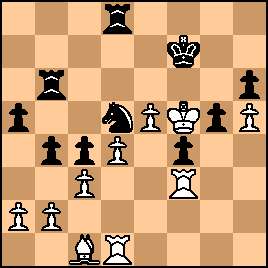
click for larger view41. Re1?
von Popiel would have had at least a fighting chance with 41. Bd2 (anticipating 41...bxc3 and allowing White to recapture with 42. Bxc3). After the text Black had the game in hand, but... 41... Ne7+
This let von Popiel back in the game. Reggio should have won with 41...bxc3 42. bxc3 Ne7+ 43. Kg4 Ke6. After the text, von Popiel had yet another chance, the position now being: 
click for larger view42. Kg4?
With 42. Ke4, White should be out of trouble. The text simply loses, and this time Reggio did not let von Popiel off the hook. 42... Ke6
42...bxc3 followed by 43...Ke6 also wins for Black. 43. Rd1
This only made matters worse. White was doubtless lost, but 43. Bd2 would have given him at least practical chances. 43... Nd5
43...bxc3 also wins and is perhaps even stronger than the text. 44. Re1 Rdb8

click for larger viewWhatever the theoretical status of the position, the game was still complicated enough that White had every reason to hope for a reversal of fortune. But White still had to make one more move in order to reach the move-45 time control. And here he blundered after which, as I will discuss in my next post on this gamae, what followed was a massacre. |
|
Oct-02-21
 | | KEG: Post VI
45. Re2?
As previously discussed, von Popiel was likely theoretically lost already, but this lemon facilitated a breakthrough by Reggio. With 45. cxb4, von Popiel could have made Reggio's task very difficult. But now, disaster overtook the White position. 45... bxc3
This move, that could and should have been played before by Reggio, appeared on the board at last and sealed von Popiel's doom. 46. bxc3 Rb1!
White is busted.

click for larger view47. Rc2
If von Popiel wanted to play on, 47. Rf1 offered the best chance, though--in fairess--that would have failed with proper play by Black after 47..Nxc3. 47... a4
47...Ra1 would also have been murder.
48. Rff2?
48. Rf1 was the only chance to prolong the game. 48... Ra1
White has no answer to the threatened 49...Rbb1. 49. Kf3 Rbb1

click for larger view50. Ba3
This only speeds the end.
50... Rg1
50...Kf5 was perhaps the fastest winning line. But--as the Tournament Book notes, the text threatens g4 and leaves White without resourse, the position now being: 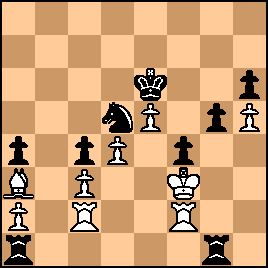
click for larger view51. Rg2 RxR
This did the trick, but 51...Rh1 was faster and simpler. 52. RxR

click for larger view52... Rh1
One of many ways to win. The Tournament Book suggests that 52...Nxc3 would let White escape cvia 53. Bf8, but in fact Black still wins with ease: 53...Rf1+ 54. Rf2 g4+ 55. Kg2 RxR+ 56. KxR Ne4+ leaving Black with no fewer than three advanced passed pawns all lusting to promote. 53. Rb2 Rh3+
54. Kg2 g4
Ouch!

click for larger view55. Rb8
Hopeless, but I've got no good ideas for White at this stage. 55... Rxc3
von Popiel might have spared himself the rest.
56. Bd6 Rc2+
56...Ne3 was even faster.
57. Kg1 g3
58. Rg8 Ne3
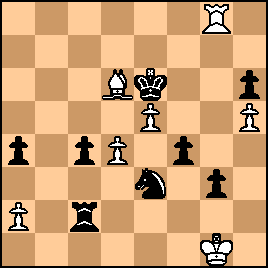
click for larger view0-1
White can at most delay mate for a few moves. |
|
|
|
|





